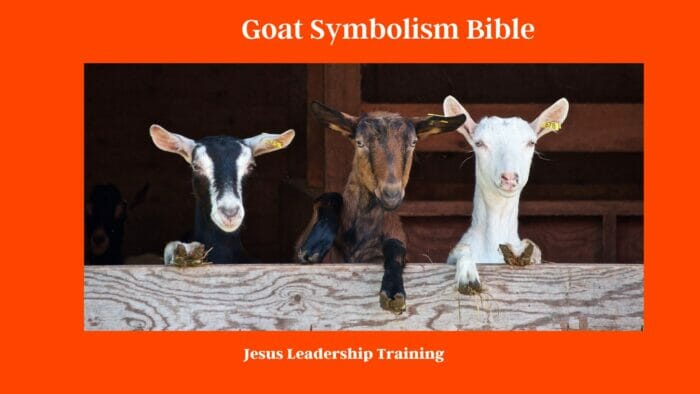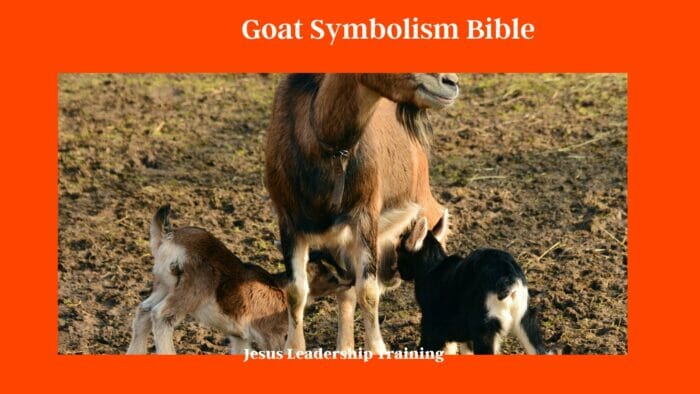In this in-depth article, we embark on an illuminating journey into the realm of goat symbolism in the Bible. Unveiling the enigmatic significance of goats in biblical texts, we explore the spiritual connotations and hidden meanings attributed to these remarkable creatures. From Old Testament references to New Testament symbolism, we delve into the profound insights offered by goats in biblical contexts. Prepare to be captivated as we uncover the secrets of “goat symbolism bible” and gain profound understanding.
Discover the fascinating world of goat symbolism in the Bible! Uncover the hidden meanings and interpretations behind these remarkable creatures. Explore the significance of goats in biblical texts and their spiritual connotations. Get ready to delve into the captivating realm of “goat symbolism bible” and gain insightful knowledge in this comprehensive article.
Table of Contents
The Presence of Goats in the Bible
Goats, prominent figures in ancient biblical times, occupy a unique place in the scriptures. Their symbolism is far-reaching and profound, often representing various virtues and qualities. From sacrificial offerings to leadership metaphors, goats symbolize diverse aspects of human life and spirituality. As we embark on this insightful exploration of “goat symbolism bible,” let us unveil the layers of meanings and interpretations attributed to these intriguing creatures.
| Biblical Account | Reference | Symbolism of Goats |
|---|---|---|
| Sacrificial Offerings | Leviticus 16:5-10, 22 | On the Day of Atonement, a goat was sacrificed for sin, and another was sent into the wilderness to remove the people’s sins, symbolizing atonement and forgiveness. The “scapegoat” represented the removal of sins. |
| Jacob Deceives Isaac | Genesis 27:9-19 | Goats were used in Jacob’s deceit of his father Isaac, symbolizing cunning and trickery. |
| Separation of Sheep and Goats | Matthew 25:31-46 | Goats represent the unrighteous who are separated from the righteous (sheep) at the Final Judgement, symbolizing those not in favor with God. |
| Daniel’s Vision | Daniel 8:5-8, 21 | A notable goat in Daniel’s vision represents the Greek Empire, demonstrating that goats can symbolize powerful nations in prophetic symbolism. |
| Goat Hair in the Tabernacle | Exodus 26:7 | Goat hair was used in the curtains of the tabernacle, symbolizing utility and practicality, as goat hair was commonly woven into fabric. |

Throughout the Bible, goats serve various symbolic roles, often representing sin, deceit, or those nations or individuals out of favor with God. However, their usefulness and practicality are also highlighted in certain contexts.
The Significance of Goats in the Old Testament
The Old Testament presents numerous references to goats, each carrying symbolic significance. Let us explore some key passages that shed light on goat symbolism in this sacred text:
- The Scapegoat Ritual: Atonement and Cleansing In Leviticus 16, the scapegoat ritual stands as a profound symbol of atonement and cleansing. As the High Priest lays the sins of the people on the goat and releases it into the wilderness, it signifies the removal of guilt and the quest for purity.
- Abraham’s Offering: Faith and Obedience In Genesis 22, Abraham’s willingness to sacrifice his beloved son Isaac at God’s command is a testament to faith and obedience. The offering of a ram caught in a thicket instead of Isaac further exemplifies God’s provision and mercy, symbolizing redemption and divine intervention.
- The Prophet Daniel’s Vision: Empires and Leadership In Daniel’s vision of four beasts (Daniel 7:1-8), the goat with a single prominent horn represents Greece and its powerful leadership. The division of the horn into four, giving rise to the four winds of heaven, symbolizes the fragmentation and emergence of subsequent empires.
- Psalm 23: The Lord is My Shepherd In this beloved psalm, the Lord is metaphorically referred to as a shepherd, and believers are likened to sheep. The imagery implies God’s guidance, care, and protection, alluding to the shepherd’s role, while goats signify the sense of individuality within the flock.

Goat Symbolism in the New Testament
The New Testament also holds intriguing references to goats, often intertwining them with spiritual lessons and moral teachings:
- Parable of the Sheep and the Goats: Judgment and Compassion In Matthew 25:31-46, Jesus uses the metaphor of separating sheep from goats to illustrate the final judgment. The sheep, representing the righteous, inherit eternal life for their compassionate actions, while the goats, representing the unrighteous, face eternal punishment for their lack of compassion.
- The Goat in the Book of Revelation: Symbol of Apostasy In Revelation 18:2, the mention of a “unclean and hateful bird” refers to the representation of apostasy. This symbol is linked to goat imagery in biblical context, emphasizing the separation between the righteous and the ungodly.
Symbolic Interpretations of Goats in Biblical Context
- Strength and Resilience: Horned Power The depiction of goats with horns in various biblical narratives symbolizes strength, resilience, and the power to overcome challenges. This symbolism conveys the idea of standing firm in faith and facing adversities with unwavering determination.
- Fertility and Abundance: Goats as Symbols of Prosperity Throughout the Bible, goats are often associated with fertility and abundance. Their ability to reproduce rapidly and provide ample resources to sustain livelihoods serves as a symbol of God’s bountiful blessings.
- Waywardness and Rebellion: The Goat as a Symbol of Straying In biblical allegory, goats may represent waywardness and rebellion. This symbolism emphasizes the importance of staying on the path of righteousness and avoiding the temptations that lead one astray.

Bible Symbolism
| Symbol | Bible Passage | Symbolism |
|---|---|---|
| Lamb | John 1:29 | In the New Testament, the lamb is a symbol of Jesus Christ, who is referred to as the “Lamb of God” who takes away the sins of the world. This symbolism is a direct reference to the sacrificial lambs in the Old Testament. |
| Dove | Matthew 3:16 | The dove is often used to symbolize the Holy Spirit, especially in the context of Jesus’ baptism when the Holy Spirit descended upon Him like a dove. It’s also a symbol of peace and purity. |
| Bread | John 6:35 | Bread is used as a symbol of life and sustenance. Jesus referred to Himself as the “bread of life,” indicating that spiritual sustenance comes through Him. |
| Light | John 8:12 | Light is used to symbolize truth and divine revelation. Jesus is referred to as the “light of the world,” meaning He brings truth and guidance to humanity. |
| Water | John 4:14 | Water is often used to symbolize purification and spiritual life. Jesus used the symbol of water when speaking to the Samaritan woman, indicating that He offers eternal life. |
| Vine | John 15:5 | The vine is used by Jesus to represent the relationship between Him and His followers. Jesus is the vine, while His followers are the branches who can do nothing apart from Him. |
| Rock | 1 Corinthians 10:4 | The rock is a symbol of stability, security, and strength. In 1 Corinthians, Jesus is referred to as the spiritual rock that accompanied the Israelites during their journey in the wilderness. |
| Lion | Revelation 5:5 | The lion is a symbol of power and majesty. In the book of Revelation, Jesus is referred to as the “Lion of Judah,” denoting His messianic authority. |
| Olive Tree | Romans 11:17-24 | The olive tree in Romans symbolizes the spiritual heritage that the Gentiles have been grafted into by faith in Christ. |
| Mustard Seed | Matthew 17:20 | The mustard seed represents faith. Even if one’s faith is as small as a mustard seed, it can move mountains. |
| Eagle | Isaiah 40:31 | Eagles are used symbolically to describe strength and renewal. Those who hope in the Lord will renew their strength and soar like eagles. |
These are just a few of the numerous symbols found within the Bible. Understanding these symbols can provide a deeper understanding of biblical teachings.
FAQs
Q: Are goats considered sacred animals in the Bible? A: While goats are not explicitly considered sacred animals in the Bible, their symbolism carries profound spiritual connotations.
Q: What does the scapegoat symbolize in Leviticus? A: The scapegoat symbolizes the removal of sins and impurities, as the High Priest transfers the sins of the people onto the goat and releases it into the wilderness.
Q: What do goats represent in the Parable of the Sheep and the Goats? A: In the Parable of the Sheep and the Goats, goats represent the unrighteous, who fail to show compassion and are separated from the righteous sheep during the final judgment.
Q: Are there any negative connotations associated with goats in the Bible? A: While goats can symbolize rebellion and waywardness, these traits serve as cautionary lessons rather than negative connotations.
Q: How does the imagery of goats as leaders appear in the Bible? A: The vision of the goat with a prominent horn in Daniel’s prophecy symbolizes the leadership of Greece and the subsequent division into four empires.
Q: How do goats signify individuality in Psalm 23? A: In Psalm 23, the metaphor of the shepherd and sheep implies the collective guidance of believers, while goats symbolize the unique individuality within the flock.
Final Thoughts: Decoding the Secrets of Goat Symbolism Bible
In conclusion, the symbolism of goats in the Bible is an intricate tapestry of spiritual insights and moral teachings. From sacrificial rituals to parabolic lessons, goats convey a diverse range of meanings in biblical texts. Their representation as symbols of strength, prosperity, and waywardness imparts profound lessons for believers across generations. As we delve into the captivating realm of “goat symbolism bible,” let us embrace the spiritual wisdom and relevance these majestic creatures hold in the sacred scriptures.




